Abstract
Miscanthus is considered a promising candidate for the cultivation of marginal land. This land poses unique challenges, and experiments have shown that the “establishment phase” is of paramount importance to the long-term yield performance of miscanthus. This experiment analyzes novel miscanthus hybrids and how their establishment on marginal land can be improved through agronomic interventions. Experiments took place at two sites in Germany: at Ihinger Hof, with a very shallow soil profile and high stone content, and at Reichwalde, where the soil was repurposed river sediment with low organic matter, high stone content, and a compacted lower horizon. These marginal conditions functioned as test cases for the improvement of miscanthus establishment agronomy. Four hybrids (Miscanthus x giganteus, Gnt10, Gnt43, and Syn55) and agronomic treatments such as plastic mulch film, miscanthus mulch, inoculation with mycorrhizal fungi, and fertilization were tested in two years at both sites in 2021 and 2022. Specific weather conditions and the timing of planting were strong determinants of establishment success and no single treatment combination was found that consistently increased the establishment success. Plastic mulch films were found to hinder rather than help establishment in both these locations. Chipped miscanthus mulch caused nitrogen immobilization and stunted plant growth. At Ihinger Hof the novel seed-based miscanthus hybrid Gnt43 produced twice the biomass of other hybrids (7 t ha−1) in the first growing season. Gnt10 yielded well in 2021 and showed impressive tolerance to water stress in the summer of 2022. No treatment combination was found that consistently increased the establishment success of miscanthus hybrids across sites and years. Novel genotypes consistently outperformed the standard commercial miscanthus hybrid Miscanthus x giganteus. Gnt10 may be a promising candidate for the cultivation of water-stress-prone marginal lands, due to its isohydric behavior and high yield potential.
1. Introduction
Climate change and the growing human population place extreme pressure on agricultural systems. Production must be increased sustainability to provide future generations with essential fuel, fiber, and biomass. The energy crop miscanthus has been put forward as a possible source of sustainable biomass in light of its low-input requirements and its ability to grow on marginal lands that are otherwise unsuitable for agricultural use. Miscanthus is a perennial, C4 biomass-crop with manifold uses in the bioeconomy [1]. While early research focused on miscanthus as an energy source [2] or a substrate for the production of biogas [3], in recent years research has shifted towards looking into the potential of miscanthus as a feedstock for the chemical industry or bio-refineries, or as a building material [4]. In addition to the benefits of miscanthus as a substrate, its cultivation may perform other important functions in the agricultural system such as protecting against erosion and nutrient leaching [5,6], acting as a habitat providing ecosystem services, and storing carbon in the soil [7].
There is great potential to reduce carbon emissions through the use of crops like miscanthus, as these crops can replace fossil fuels and contribute to storing carbon in the soil. However, their uptake by farmers has been low, and this relates to uncertainty about their cultivation, a lack of markets for biomass, and a narrow range of varieties available. In addition, diversion of arable land from food production to biomass crop cultivation is undesirable, as this may cause food price fluctuations and raise ethical concerns [8,9]. Therefore, expansion of biomass crop production should occur on so-called “marginal land”, where Mellor et al. define marginal land as follows: ”Marginal land is any identifiable land area, whether originally agricultural or non-agricultural, including those in urban areas, which is currently unused or underutilized due to economic, environmental or social factors, but which is suitable for temporary or longer term use for sustainable energy production” [10]. Various factors can lead to land being classified as marginal, such as soil quality, erodability, fertility, slope, stoniness, location, profitability, the presence of heavy metals, and salinity [11,12].
Miscanthus is well suited for cultivation on marginal land by virtue of its broad stress tolerance [13]. Across its native range in east Asia, spanning from Siberia in the north to the tropics in the south, wild miscanthus is found growing in many different climates, with a variety of marginality factors, and has adapted accordingly. Indeed, it has been posited that a large amount of marginal land could be successfully cultivated with miscanthus [13,14]. However, the success of any miscanthus plantation is contingent upon a successful establishment [15,16]. As a perennial crop, replanting of miscanthus to fill in gaps in the field after the initial planting is difficult, as this could damage the existing crop. For this reason, the density of a newly planted miscanthus stand is determined by the establishment rate of the crop in the first year. To establish successfully, a miscanthus plant must grow well in the first growing season in order to store enough nutrients to remerge the following spring. Plants must also be hardy enough to survive the first winter. Patchy miscanthus stands have lower yields [16] and weeds may become established in gaps between plants, increasing competition with the crop [15]. Yields of miscanthus generally increase for the first three to five years following planting before reaching a plateau, whereby patchy and poorly established miscanthus stands take longer to reach peak yields [17,18]. How well the plants are established determines how quickly peak yields are achieved and how soon the stand becomes profitable.
Aside from its tolerance of marginal conditions, miscanthus may be a good fit for marginal land, as it requires few inputs after the initial establishment [19], and thus has lower overheads compared to a more conventional crop such as maize, assuming that marginal land delivers lower profits. However, the very marginality that makes miscanthus a suitable candidate also makes the crucial establishment phase especially difficult.
Overcoming marginality in order to establish miscanthus requires looking at factors that impact establishment and how these can be influenced. These include choice of hybrid, planting density, water availability, weed pressure, weather conditions, quality and type of planting material, soil conditions, and the use of agronomic treatments [20,21,22]. Barriers to establishment can be overcome by applying treatments or modulating one or more of these factors. For example, high losses can occur after planting miscanthus due to hot, dry conditions that cause desiccation. One solution to this problem is irrigation, though on marginal land this is likely too expensive. Another solution may be an earlier planting date, higher quality planting material, or a higher planting density to offset expected losses. However, in this example, changing the planting date has other effects on the success of the establishment. The beginning of miscanthus’ planting window is determined by its base growing temperature and the prevalence of spring frost at a given location, while the end of the planting window is determined by the harshness of conditions and dryness towards the end of spring [23]. Earlier planting dates increase the risk of frost exposure while later planting dates result in a shorter growing season, in which the plant must store resources required for growth in the next season [24]. Thus, changing the planting date to avoid desiccation may result in higher losses due to frost.
The problem of establishing miscanthus is thus a complex one, and researchers are making headway towards solving it. Novel hybrids with improved stress tolerance that can be propagated via seed have been developed [25,26]. Most commercially grown miscanthus is of the hybrid Miscanthus x giganteus (hereafter Mxg), a naturally occurring sterile hybrid of Miscanthus sinensis and Miscanthus sacchariflorus. This hybrid is highly productive, though it can only be propagated clonally due to its sterility, which in turn hinders its large-scale deployment due to low replication rates and high costs [25]. Rhizome replication requires nursery fields and has a low replication rate. Newly developed hybrids thus allow for faster upscaling and lower costs associated with establishment. In addition to novel hybrids, other research has sought to improve establishment by looking at variables such as planting date, pot size, time in greenhouse, and the use of agronomic treatments such as plastic mulch film [20,27,28,29,30,31,32].
This experiment looks at several novel miscanthus hybrids and how their establishment on marginal land can be improved through agronomic interventions. It builds upon previous research using novel hybrids and agronomic interventions trialed in other experiments, but applies these on marginal land. Field trials were set up over two years at two sites across Germany with marginal conditions. The effects of various planting dates, plant propagation methods, mulch treatments, fertilization, and mycorrhiza were examined. The objective was to find ways to make establishing miscanthus more reliable; specifically, if the survival rate and yield of newly establish stands could be improved on marginal sites and with novel hybrids.
2. Materials and Methods
To test the effect of various treatments on the establishment of miscanthus, experiments were carried out at Ihinger Hof near Stuttgart in southern Germany and at Reichwalde in eastern Germany. Both of these sites are so-called “marginal land” and were chosen for this reason.
Four experiments were carried out in total. One experiment was established at each site at the start of 2021 and again at the start of 2022. Experiments planted in 2021 ran for two years until the end of 2022. These experiments are referred to as “Ihinger Hof A” and “Reichwalde A” to avoid confusion with experiments planted in 2022.
The experiments established in 2022 will be referred to as “Ihinger Hof B” and “Reichwalde B”. Each site and experiment contained different combinations of hybrids and treatments.
2.1. Study Sites
The study site at Ihinger Hof is located approximately 25 km west of Stuttgart, (48°44′05.3″ N, 8°55′54.4″ E). The site is characterized by shallow, stony rendzina soil. The soil profile in parts of the field was extremely shallow. This was discovered when soil probes were taken, where the soil profile was found to have a depth of approximately 20–30 cm in some parts of the field. Shallow, stony soils have limited water holding capacity, and for this reason the site was considered as marginal. Long-term measurements from a weather station at the site show an average of 687 mm precipitation each year and an average temperature of 8.5 °C. The site is a temperate maritime climate and lies between 460 and 520 m above sea level.
The experimental site at Reichwalde is located on the edge of the Reichwalde open-cut coal mine in eastern Germany (51°23′03.7″ N, 14°42′28.6″ E). The site was previously used as a carpark for heavy vehicles before being repurposed. As such, the lower soil horizon is extremely compacted. The upper soil layer was formed when river sediment from the redirection of a nearby creek was dumped on the site in a layer 60–100 cm thick. A soil survey carried out at the site prior to the commencement of the experiment revealed very low humus content and low phosphorous content. The upper soil layer was highly permeable to water, while the lower horizon was extremely impermeable. This resulted in a site that dried out quickly during the summer and that was waterlogged each year between October and April. The site also had a very high stone content, such that stones had to be removed by hand to allow ploughing to occur. On the German soil classification scale, soil surveyors gave this site 23–30 out of a possible 100 points. For these reasons, the site can be classified as marginal land. Weather data were available from a weather station near to the site from 2009 onwards, giving an average temperature of 10.5 °C and yearly average precipitation of 579.9 mm [33]. The site has a continental temperate climate. Figure 1 shows temperature and precipitation data for the experimental period for both sites.

Figure 1.
Long term precipitation and temperature data from Ihinger Hof and Reichwalde.
2.2. Treatments
Various treatments were selected based on previous experiments conducted on this topic. The treatments are detailed in Table 1. The reasoning for employing the chosen treatments was as follows; Different planting dates involve differential risks of frost exposure, but also affect the length of the plant’s growing season [24]. Trialing different planting dates allowed the effect of other treatments to be evaluated, regarding how well they protected against frost or desiccation. Plastic mulch has been shown to improve the establishment of miscanthus in temperature climates by increasing the temperature around the plant and keeping in moisture [29,30]. Miscanthus mulch was chosen because it was theorized that it could have a weed-suppressant effect. Mycorrhizal fungi were chosen to improve the nutrient availability at the Reichwalde site, as soil coring had shown low fertility in the soil. Fertilizer was applied for the same reason. The combination of fertilizer and miscanthus mulch arose due to the observed negative effect of miscanthus mulch on the growth of miscanthus in the experiments Ihinger Hof A and Reichwalde A. It was thought that nitrogen immobilization was stunting growth; thus, fertilizer might counteract this effect. Overwintering was thought to produce plants that would be stronger and more resistant to stress, similar to work carried out by Ashman et al. [20].

Table 1.
Description of treatments applied and the reasoning behind them.
2.3. Planting Material
Four miscanthus hybrids were tested. The combination of hybrids and treatments was different in each experiment. Table 2 details the properties of the hybrids tested.

Table 2.
Description of hybrids used in this establishment experiment as well as their origins and important characteristics.
Three of the varieties tested originated from the miscanthus breeding program at Aberystwyth university. Gnt10 and Gnt43 are the result of crosses between a Chinese M. sacchariflorus variety and a Japanese M. sinensis. Gnt10 is a sterile variety that can only be propagated clonally. Gnt43 emerged from a later stage in the same breeding program; hence the higher number. Gnt43 and Syn55 produce fertile seed while Gnt10 and Mxg are sterile. Anecdotally, Gnt43 seeds had a higher germination rate than Syn55 and produced stronger plantlets.
For the seed-based varieties, Syn55 and Gnt43, plants were sown in a greenhouse, and so-called “plug plants” were produced, which were then planted in the field. Seeds were sown each year in December, approximately 4–5 months before planting. Seeds were sown on a tray of sand covered with a layer of paper towel, moistened with water, enclosed under a plastic film. Trays were kept at approximately 28 degrees °C in the greenhouse or in an incubation chamber in a 12 h day/night cycle. Following germination, plants were transferred from the sand trays to 126 pot multi-trays, where each plant was placed in a pot of volume 60 cm3 filled with potting mixture. Plants were watered every two days or more often if required, and fertilized regularly. When plants reached approximately 30 cm tall, they were trimmed regularly to promote shoot formation. Trays containing plants were moved outside a few days before planting to allow them to acclimate to outdoor weather conditions. For the early planting date treatment, Gnt43 plants were sourced from Aberystwyth and had been overwintered.
Gnt10 plants were sourced from JKI Braunschweig. In vitro GNT10 plantlets were very small upon arrival and significantly less developed than other hybrids. Plantlets were transferred to 60 cm3 pots and stored in the greenhouse with other plantlets until plating.
Mxg plants were sourced from in vitro suppliers or grown from rhizomes. Due to a late shipment of plantlets, the first planting date in the Ihinger Hof A experiment was planted using rhizomes. Rhizomes were dug out from a plot at Hohenheim University, washed, and stored in moist plastic bags prior to planting. The second planting date in the Ihinger Hof B experiment used Mxg plants in large (approx. 11 cm diameter) pots. These plants were significantly larger than other hybrids.
2.4. Experimental Layout
2.4.1. Ihinger Hof A—Established 2021
This experiment consisted of four experimental blocks, where half of each block was planted on 10 May 2021 while the remaining half was planted on 25 May 2021. Each block contained 24 plots of 3.33 m × 4.5 m, where each plot was 15 m2 and contained 30 miscanthus plants at a density of 2 plants m−2. Each block at Ihinger Hof contained each hybrid in combination with each treatment and planting date. The design was a split-split design.
The planting area was ploughed and then cultivated with a rotary harrow prior to each planting. Soil active herbicides pendimethalin (2.5 L ha−1, Stomp Aqua®, BASF SE, Ludwigshafen, Germany) and Dimethenamid-P (1.25 L ha−1, Spektrum®, BASF SE, Ludwigshafen, Germany) were applied on the day of planting, except in plots treated with miscanthus mulch. A subsequent herbicide application was carried out on 9 July using a mixture of Arrat (active ingredient Dicamba 500 g kg−1 Dicamba, Trisulfuron 250 g kg−1 Tritosulfuron, application rate 200 g ha−1, BASF SE, Ludwigshafen, Germany), MCPA (active ingredient 500 g L−1 MCPA, application rate 1.0 L ha−1, Nufarm Deutschland, Cologne, Germany), Callisto (active ingredient 100 g L−1 Mesotrione, application rate 1.0 L ha−1, Syngenta Agro, Frankfurt, Germany), and Dash (application rate 1.0 L ha−1, BASF SE, Ludwigshafen, Germany). Subsequent weed control was carried out by hand.
2.4.2. Ihinger Hof B—Established 2022
Experiment B consisted of five blocks, each containing 15 experimental plots of 3 m × 3.33 m, each having an area of 10 m2 and containing 20 plants at a density of 2 plants per square meter. Each block represented one replication, and in each block each treatment was combined with each genotype in a randomized complete block design. Plastic mulch blocks were adjacent to each other to aid application. Prior to this experiment this field had been used to cultivate maize and lupine. Before planting the field was harrowed and stones were removed from the experiment area by hand. Miscanthus was planted on 29 April 2022. Herbicide was applied at planting as in the experiment Ihinger Hof A, including in plants containing miscanthus mulch. A second herbicide application of a leaf active herbicide was carried out, as in the experiment Ihinger Hof A, on 17 June 2022.
2.4.3. Reichwalde A—Established 2021
At Reichwalde A planting took place on 27 May 2021. This experiment consisted of five experimental blocks, each of which contained 15 plots of dimensions 3.33 m × 4.5 m, each containing 30 plants. Each block contained each hybrid in combination with each treatment and represented one replication. The design was a split plot design. Mxg plants were excluded from analysis at this site as the plants supplied were found to be of another unknown hybrid.
The mycorrhiza treatment (detailed in Table 1) was only applied to Gnt43 and this combination was treated as its own hybrid in the analysis. The field was ploughed prior to planting and stones were removed from experimental plots by hand. Herbicide was applied at planting as a mixture of Stomp and Spektrum as at Ihinger Hof. Further weed control was carried out on July 5th with an application of 1.0 L Calaris (active ingredient 330 g L−1 Terbuthylazin, 70 g L−1 Mesotrione, Syngenta Agro, Frankfurt) und 0.9 L DualGold (active ingredient S-Metolachlor 960 g L−1, Syngenta Agro, Frankfurt) ha−1 by hand. In 2022 weed control was carried out by hand.
2.4.4. Reichwalde B—Established 2022
Planting at Reichwalde B took place on 5 May 2022, with plastic mulch and other treatments applied on 6 May 2022. Six experimental blocks containing 12 plots each were planted, where plots had the same size and dimensions as those in Ihinger Hof B (10 m2). The field was ploughed prior to planting and stones were removed from experimental plots by hand. Herbicide was applied as a mixture of Stomp and Spektrum as at Ihinger Hof, and subsequent weed control was carried out by hand throughout the year. Table 3 details the treatments tested in each experiment.

Table 3.
Experimental set up of establishment experiments A and B established in 2021 and 2022 respectively.
Table 4 details which hybrids were tested in each experiment.

Table 4.
Hybrids tested in each experiment.
2.5. Field Measurements
Following planting, measurements of plant growth were taken each year until the end of the vegetation period in October or November, when plants showed signs of senescence. In the first year after planting, measurements were taken from the innermost six plants in each experimental plot. In the second year, measurements were taken from three of these plants.
Plant height was measured from the ground to the final internode of the highest stem on a given plant. Total stem number was also measured, whereby newly emerging shoots were counted as well as more established stems. At each measurement date, the total survival rate of each experimental plot was scored and expressed as a fraction. Plants were counted as dead when no green leaf matter was present, though at the end of the vegetation period this was not a reliable measure as the plants became senescent. The number of plants emerging following the first winter after planting was also recorded.
2.6. Soil Sampling
Soil samples were taken at Ihinger Hof and Reichwalde to understand the edaphic conditions present at each site. Initial soil samples were taken to a depth of approximately 90 cm (where possible) with an auger of diameter 4 cm. In 2022 soil cores were taken from each experimental plot in experiments Reichwalde B and Ihinger Hof B to understand the effect of fertilization and mulch treatments on soil mineral availability. Soil samples were taken with a hand-held auger of diameter approximately 2.5 cm to a depth of 30 cm. Soil samples were stored on ice to avoid ammonia losses and then analyzed to determine their nitrogen content.
Plant-available nitrogen in fresh soil (NO3 and NH4; referred to as Nmin) was determined using a CaCl2 extraction and FIA (flow-injection analysis) measurement (DIN ISO 14255:1998-11) [34].
Soil sensors, sourced from the company Tomst [35], were placed in experimental plots in early 2021 and at the beginning of the vegetation period in 2022, and recorded soil and air temperature as well as soil moisture. These sensors measured the temperature at the surface every 5 min as well as soil moisture.
2.7. Harvest
The yield of each experimental plot was determined by a destructive harvest in spring following the first winter after planting. Three plants were randomly selected from the innermost 6 plants in each plot, and then harvested by hand at a height of approximately 5 cm. Plants were then dried at 100 °C to a constant weight to determine dry matter yield.
The yield was calculated by dividing the harvest area by the yield, and then multiplying this by 10,000 to attain tons per hectare. This was then multiplied by the measured survival rate to correct for missing plants.
Experiment A at Ihinger Hof was harvested on 18 March 2022 after the first vegetation period and winter. The second-year regrowth was harvested on 16 March 2023. Experiment Ihinger Hof B was harvested on 14 March 2023.
The Reichwalde A experiment was harvested using the same method on 5 May 2022. The yield of the second vegetation period was determined by harvesting plants on 28 March 2023. At this date Reichwalde B was also harvested.
2.8. Statistical Analysis
Statistical analysis was carried out using R studio and conducted using SAS version 9.4 [36,37]. In SAS the program “PROC GLIMMIX” was used. Each experiment and measurement date was analyzed separately. No two sites were analyzed together.
2.8.1. Analysis of Ihinger Hof A
Data from experiment Ihinger Hof A were analyzed using the following mixed general-linear model.
where is the measurement of the hth hybrid in the ith treatment planted on the jth planting date in the kth block;
is the intercept;
is the fixed effect of the hth hybrid (Gnt10, Gnt43, Mxg, Syn55);
is the fixed main effect of the ith treatment (Control, miscanthus mulch, plastic mulch);
is the fixed main effect of the jth planting date (Early, Late);
is the fixed interaction effect of the hth hybrid with the ith treatment;
is the fixed interaction effect of the hth hybrid with the jth planting date;
is the fixed interaction effect of the ith treatment with the jth planting date;
is the fixed interaction effect of the hth hybrid, the ith treatment and the jth planting date;
is fixed effect of the kth block;
is the random main-plot error effect of the jth planting date in the kth block;
is the random middle-plot error effect of the hth treatment in the kth block on the jth planting date;
is the slope on the number of measure plants surviving in an experimental plot is the number, and is the error of with hybrid-specific variance, if the latter increased model fit measured via AIC [38].The homogeneity and normality of residuals was examined graphically. In case of deviations, data were transformed using the logarithm or using the arcus sinus square root transformation. Data analysis was performed using SAS software, using the PROC GLIMMIX procedure.
Wald’s test was used to determine which factors were significant. Subsequently, Fisher’s test was used to compare the means of factors where a significant effect was detected.
2.8.2. Analysis of Ihinger Hof B, Reichwalde A, and Reichwalde B
These experiments were originally planned as randomized complete block designs. However, plastic mulch treatment plots were all adjacent to aid application. In these cases, a kind of split-plot design was therefore considered in the model. Note that for all non-plastic mulch treatments, the sizes of main-plots and plots were identical and the split into two variances was only based on plastic mulch observations. The model can be described as follows:
where is the random main-plot effect of the ith treatment in the jth block and all other effects were analogouly defined as in model (1).
For the analysis of all four expeiments, the homogeneity and normality of residuals was examined graphically. In case of deviations, data were transformed using a logarithmic or arcsine square root transformation [39]. Estimated means were afterwards back-transformed for presentation purposes. Estimated standard errors were back-transformed using the delta method. After finding significant effects via the global F-test or Wald’s test, a Fisher’s LSD test was used and its results were presented via letter display. Data analysis was performed using SAS software, using the PROC GLIMMIX procedure.
3. Results
3.1. General Trends
The 2021 growing season at Ihinger Hof was particularly wet when compared with long-term weather data. This wet growing season resulted in very large plants for a first-year stand of miscanthus. Yields of the best performing hybrid exceeded 7 t ha−1 in the control. In contrast, 2022 was very dry, specifically during summer, typically the period when most biomass is produced. In July 2021, 87.3 mm of rain fell, compared with 25.7 in July 2022 (Figure 1). Miscanthus stands planted in 2022 at Ihinger Hof were much smaller at the first harvest compared with plants from 2021, with the best performing hybrids and treatments producing slightly more than 1 tha−1.
Conditions at Reichwalde were drier and warmer than at Ihinger Hof, and this difference was visible in plant growth (Figure 2). The experimental site is located in a continental climate, and is notorious for cold winters and hot summers, and a rapid transition from cool to hot conditions in the spring. Planting took place on 27 May, and from 1 June 2021 until 23 June 8 mm of rain fell, while temperatures reached 28 °C.
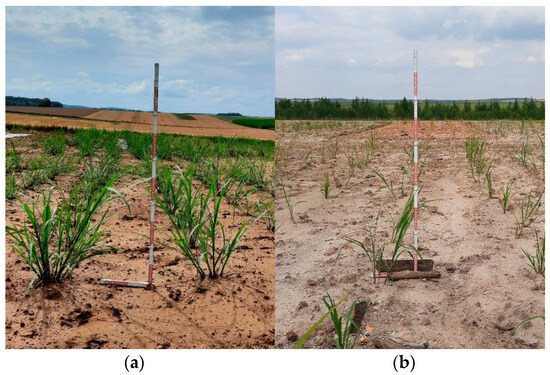
Figure 2.
(a) Gnt10 in the control at Ihinger Hof in the first growing season on 27 July 2021; (b) Gnt10 in the control at Reichwalde on 23 July 2021.
In 2022, a dry period at Ihinger Hof showed strong differences in water-stress tolerance between hybrids. Figure 3 shows Syn55, Gnt10, Gnt43, and Mxg in the control treatment in August 2022, where Syn55 and Gnt10 remained green while Mxg and Gnt43 showed signs of water stress.

Figure 3.
Various hybrids in the control treatment on 22 August 2022 at Ihinger Hof. The length of the measuring stick pictured is 200 cm.
The main agronomic interventions tested in all experiments—miscanthus mulch and plastic mulch—generally had a negative effect on plant growth and/or survivorship. Plants under miscanthus mulch yellowed immediately following planting and were consistently smaller than their counterparts in the control. Plants under plastic mulch had low survival rates immediately following planting.
The following sections outline the findings in each individual experiment in greater detail.
3.2. Ihinger Hof A
3.2.1. Plant Height
Measurements of plant height are shown in Figure 4. The p-values of global F-tests carried out in Ihinger Hof A and Ihinger Hof B are shown in Table 5.
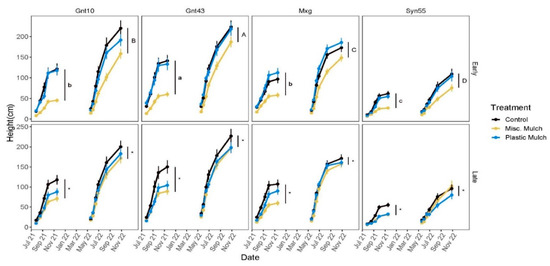
Figure 4.
Plant height in the Ihinger Hof A experiment from 2021 to 2022. Early-planted stands are shown in the top row, while late-planted stands are shown in the bottom row. Comparisons were carried out between hybrids and within years. However, both planting dates are shown separately. Hybrid–planting date combinations marked with an asterisk are grouped with those directly above them, marked with a letter, for statistical comparisons. Treatment–hybrid combinations with the same letter are not significantly different at α = 0.05. Lower-case letters denote comparisons made in the 2021 growing season. Upper-case letters represent comparisons of the 2022 growing season.

Table 5.
p-Values of global F-tests of Ihinger Hof A and Ihinger Hof B data. Bold marked p-values are smaller than 0.05.
Hybrid, treatment, and the interaction of treatment and planting date had an effect on the height of plants in 2021. No difference was found between early (76.7 cm) and late plantings (75.1 cm).
Gnt43 plants were on average 107.8 cm tall, significantly taller than Gnt10 (88.3 cm) and Mxg (84.5), and all three hybrids were significantly taller than Syn55 (41.3 cm). It was observed that Gnt43 plants began to lodge at the end of the growing season. Plants in the control had an average height of 100.8 cm, significantly taller than those in the plastic mulch treatment (84.4 cm). Plants in both these treatments were in turn significantly taller than the miscanthus mulch treatment (51.4 cm). For the control, there was no difference between early- and late-planted blocks. For plastic mulch, early blocks had an average height of 99 cm, which was significantly higher than plants in the late treatment (71.9 cm). For miscanthus mulch, late-planted blocks (58.3 cm) were larger than early-planted blocks (45.3 cm).
All hybrids differed significantly from one another in the 2022 growing season. Gnt43 was the tallest with an average height of 207.7 cm, followed by Gnt10 (186.3 cm), Mxg (165.6 cm), and Syn55 (93.5 cm). The control (169.8cm) and plastic mulch (157.2cm) treatments were significantly taller than the miscanthus mulch treatment (134.6 cm). As in 2021, miscanthus mulch treatments were taller when planted late, while plastic mulch and the control treatments were taller when planted early.
3.2.2. Stem Count
Hybrid, planting time, treatment, and the second order interactions of these factors had an effect on stem count in 2021 (Figure 5). Late-planted blocks had 29.6 stems on average compared with 24.1 for early-planted blocks. Gnt43 had the most stems per plant (34.1), significantly more than Gnt10 (27.2) and Mxg (28.9). All hybrids had significantly more stems than Syn55 in 2021, which had 19 on average.
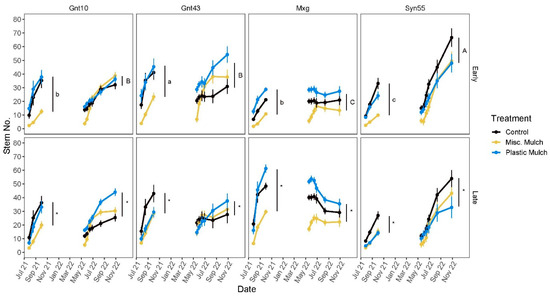
Figure 5.
Stem count in the Ihinger Hof A experiment from 2021 to 2022. Early-planted stands are shown in the top row, while late-planted stands are shown in the bottom row. Comparisons were carried out between hybrids, within years, but both early and late plantings are shown separately. Hybrid–planting date combinations marked with an asterisk are grouped with those directly above them, marked with a letter, for statistical comparisons. Treatments with the same letter are not significantly different at α = 0.05. Lower-case letters denote comparisons made in the 2021 growing season. Upper-case letters represent comparisons of the 2022 growing season.
Miscanthus mulch resulted in significantly fewer stems per plant (17.4) when compared to the control (34.7) and plastic mulch (31.7). In the plastic mulch treatment, there was no significant difference between planting dates; in the control and miscanthus mulch treatments, late-planted blocks had more stems. A large difference was observed between early-planted Mxg (18.8 stems per plant) and late-planted Mxg (44.5 stems per plant), which is likely due to the different planting material used.
In 2022 no difference was detected in stem counts for different planting dates. However, the hybrid with the most stems was Syn55 (49.1), which had significantly more than Gnt43 (36.7) and Gnt10 (34.5), which were both significantly higher than Mxg (22.8). This is an inversion of the trend seen in the first year of the experiment. Plastic mulch had the most stems (39.5), which was significantly more than that of miscanthus mulch (33.4). The control was not different from either treatment, with 35.9 stems. In both years the effect of survival rate was highly significant on stem number.
3.2.3. Yield
Yield averaged across treatments was highest in 2021 in Gnt43 (3.3 t ha−1), significantly higher than in Gnt10 (2.4 t ha−1) and Mxg (2.3 t ha−1), while Syn55 had a yield significantly lower than all other hybrids at 0.9 t ha−1. This is shown in Figure 6.
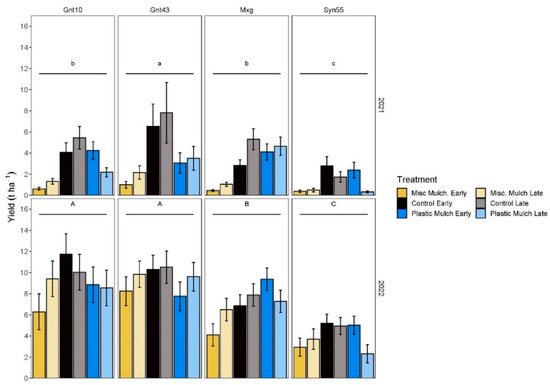
Figure 6.
Dry matter yields in the Ihinger Hof A experiment from the 2021 and 2022 growing seasons. Harvests were taken in the spring of 2022 and 2023. Comparisons were carried out between hybrids within years. Lower-case letters indicate mean comparisons in 2021 and upper-case letters indicate mean comparisons in 2022. Treatment–hybrid combinations with the same letter are not significantly different at α = 0.05. Lower-case letters denote comparisons made in the 2021 growing season. Upper-case letters represent comparisons of the 2022 growing season.
The control treatment had the highest yield (4.1 t ha−1), significantly more than plastic mulch (2.5 t ha−1), which in turn was significantly higher than the yield under miscanthus mulch (0.8 t ha−1).
The highest yield attained in 2021 considering individual treatments was the Gnt43 control with a yield of 7.2 t ha−1. A significant interaction between planting time and treatment was observed. For the control, there was no significant difference between early and late plantings. For plastic mulch, early plantings had an average yield of 3.4 t ha−1, compared to 1.8 t ha−1 in late plantings. For miscanthus mulch, the opposite pattern was observed, wherein the late planting yielded 1.1 t ha−1, which was significantly more than the average yield of 0.6 t ha−1 in early plantings. A similar interaction to that for stem height was found for yield between hybrid and planting date. Syn55 yielded more when planted early, while Mxg yielded more when planted late. Again, this is likely an artefact of the different planting material used for Mxg.
3.2.4. Survival
Survival in 2021 was highest in late plantings of Mxg (97.6%) and lowest in early plantings of GNT43 (74.4%). No difference in survival rate was found between the two plantings (Figure 7).
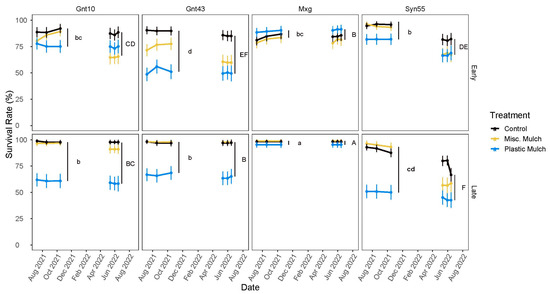
Figure 7.
Survival rate in the Ihinger Hof A experiment. Early-planted stands are shown in the top row, while late-planted stands are shown in the bottom row. Comparisons were carried out between hybrids and planting dates, within years. Lower-case letters represent mean comparisons from 2021, while upper-case letters represent comparisons from 2022. Hybrid–planting date combinations with the same letter are not significantly different at α = 0.05. Lower-case letters denote comparisons made in the 2021 growing season. Upper-case letters represent comparisons of the 2022 growing season.
In the control, 93.8% of plants survived and 92.6% of plants in the miscanthus mulch treatment survived. Both survival rates were significantly higher than that for the plastic mulch treatment, in which 73.5% of plants survived.
The survival rate were high in the late-planted miscanthus mulch treatment (96.9%), and was significantly higher than in the early planting of miscanthus mulch (86.4%). There was otherwise no difference between early and late plantings within treatments.
Gnt10 under plastic mulch, Syn55 under plastic mulch, and Hnt43 under plastic mulch had significantly lower survival rates than all other hybrid–treatment combinations.
In 2022, after the first winter no significant difference was found in survival rate between early and late plantings. The control had the highest survival rate (89.5%), significantly higher than that of miscanthus mulch (80.7%), both of which were significantly higher than that of plastic mulch (70.3%).
Mxg had the highest survival rate of all hybrids (93.1%), significantly higher than that of GNT10 (81.7%) and Gnt43 (79.3%). All hybrids had a significantly higher survival rate than Syn55 (64.8%). For miscanthus mulch, the survival rate in early plantings (68.9%) was significantly lower than in later plantings (90.2%). Similarly, the survival rate in later plantings of the control (93%) was higher than in early plantings (85.4%). For comparisons between hybrids across both planting dates, Gnt43, Syn55, and Mxg all had a higher survival rate at the end of the experiment when planted late than when planted early.
3.3. Ihinger Hof B
3.3.1. Height
The effects of hybrid, the interaction of hybrid and treatment, and the survival rate had an impact on the height of plants in the Ihinger Hof B experiment (Figure 8). Gnt43 plants were tallest on average (105 cm), more than twice the height of Mxg plants (42.4 cm) and Syn55 (33.8 cm). Differences between treatments within hybrids were minimal.

Figure 8.
Plant height and stem count for various treatments in experiment Ihinger Hof B in 2022. Comparisons were carried out between hybrids for height, and between hybrids and treatments for stem count. Hybrids with the same letter are not significantly different at α = 0.05.
3.3.2. Stem Count
Stem count was influenced by hybrid and treatment (Figure 8). Mxg had the highest number of stems, with 50.4 per plant on average, significantly higher than GNT43 (38.6) and syn55 (34.8). The plastic mulch treatment produced the highest number of stems (46.8 cm), while the miscanthus mulch had the fewest stems (35.1). The miscanthus mulch and miscanthus mulch plus fertilizer treatments performed similarly in all hybrids, and both treatments’ values were significantly lower than those of the remaining three.
3.3.3. Yield
Weather conditions in 2022 were considerably drier than in 2021 and first-year yields were lower than in the Ihinger Hof A experiment (Figure 9). Gnt43 yielded 0.93 tha−1, significantly more than Mxg (0.16 tha−1) and Syn55 (0.13 t ha−1) in early 2023. The effect of treatment was not significant (p = 0.0599), but a notable trend was observed, wherein the plastic mulch treatment had the highest yield in each hybrid.
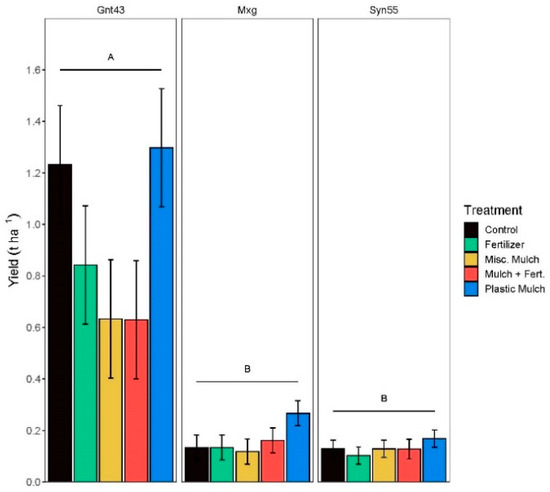
Figure 9.
First-year yields of miscanthus hybrids planted in April 2022 at Ihinger Hof. Hybrids with the same letter are not significantly different at α = 0.05.
3.3.4. Survival Rate
The survival rate at the end of 2021, before the first winter, was significantly higher in Gnt43 (91%) and in Mxg (88.9) than in Syn55 (73.2%), this is shown in Figure 10. Survival was difficult to estimate in the summer months as plants often appeared dead above ground due to desiccation, before reemerging later on. In summer 2023, following the first winter the survival rate of Gnt43 was 88.6% and the survival rate in Mxg was 90.3%, both significantly higher than Syn55 at 56.9%. Across all hybrids, survival was highest in the plastic mulch treatment at 88.5% and lowest in the control (76.6%). Pairwise comparisons show, however, that in Gnt43 and Mxg there were significant differences between treatments.

Figure 10.
Survival rate of various hybrids under different treatments planted at Ihinger Hof in April 2022. Treatment–hybrid combinations with the same letter are not significantly different at α = 0.05.
3.3.5. Soil Samples
Measurements of mineral nitrogen taken throughout the vegetation period (Appendix A.1) show a consistent pattern across hybrids. Fertilizer treatments had the highest available mineral nitrogen in the middle of the growing season, followed by the control, plastic mulch, and mulch and fertilizer treatments. Miscanthus mulch had consistently lower mineral nitrogen at each measurement than other treatments.
3.4. Reichwalde A
3.4.1. Plant Height
Plant height followed a similar pattern in Reichwalde A in 2021 as the Ihinger Hof experiment (Figure 11). Gnt43 was the tallest hybrid and Syn55 the smallest. Significant differences were detected between the control and miscanthus mulch and between the plastic mulch treatment and the miscanthus mulch treatment. In 2022, syn55 was shorter than all other hybrids. No significant treatment effect was found, but a significant interaction between hybrid and treatment was detected. This is evident in the different reaction of Gnt43+ Mycorrhiza to plastic mulch compared with Gnt43. Table 6 shows the p-values of F-tests carried out for data from Reichwalde A and B.
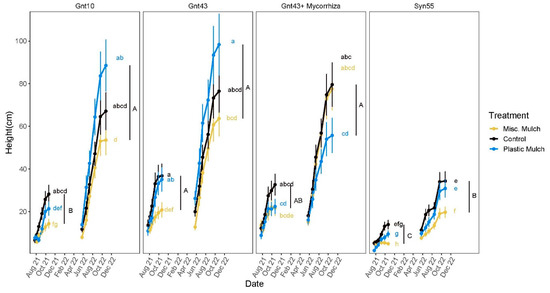
Figure 11.
Plant height in the Reichwalde A experiment from 2021 through 2022. Lower-case letters represent comparisons across all treatment levels and hybrids. Comparisons between hybrids are represented by upper-case letters. All comparisons are made within years. Treatment–hybrid combinations with the same letter are not significantly different at α = 0.05.

Table 6.
p-Values of global F-tests of Reichwalde A and Reichwalde B data. Bold marked p-values are smaller than 0.05.
3.4.2. Stem Count
No differences were found between the stem counts of any hybrids (Figure 12). However, a significant treatment effect was detected, wherein miscanthus mulch treatments had significantly fewer stems. This held true in 2022. In 2022 the survival rate also became significant.

Figure 12.
Stem count of miscanthus hybrids planted at Reichwalde in May 2021. Treatments with the same letter are not significantly different from each other.
3.4.3. Yield
Yield was extremely low in both years with no hybrid or treatment exceeding 0.3 tha−1 in 2021 (Appendix A.2). In 2022, only the Gnt43 plastic mulch treatment and the Gnt10 control reached 1 t ha−1. In 2021, the control and plastic mulch treatments were significantly better than the miscanthus mulch treatment. However, in 2022, only the interaction of hybrid and treatment was significant, reflecting how for some hybrids the plastic mulch treatment was the best performing and for others the lowest performing.
3.4.4. Survival Rate
The survival rate followed a different trend to measurements of height, stem number, and yield (Appendix A.3). Plastic mulch was the worst treatment in this metric, where the survival rate was significantly lower than in the other treatments. At the end of 2021, 96.1% of plants in the miscanthus mulch treatment and 93.7% of plants in the control were alive, compared with 84.5% of those under plastic mulch. In 2022, the survival rate in the control fell to 84.7%, while in miscanthus mulch it was 84.8%, both significantly higher than in the plastic mulch treatment at 67.1%.
3.5. Reichwalde B
3.5.1. Height and Stem Count
The Reichwalde B experiment was located adjacent to the Reichwalde A experiment. No treatment differences were detected in the height of plants, while Gnt43 (64.7 cm) was significantly taller than Mxg (36.7 cm) (Figure 13). Mxg plants had more stems than Gnt43 (34.5 vs. 21.9). Plastic mulch, fertilizer, and mycorrhiza treatments had significantly more stems than miscanthus mulch and miscanthus mulch and fertilizer treatments.
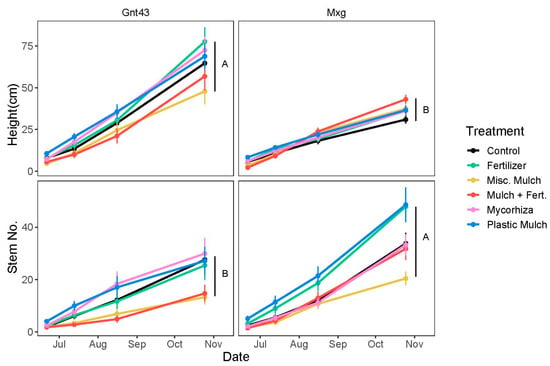
Figure 13.
Height and stem count of miscanthus hybrids planted at Reichwalde in May 2022. Hybrids with the same letter are not significantly different at α = 0.05.
3.5.2. Yield
Yields were significantly different between hybrids, though no effect of treatment was detected (Figure 14). Gnt43 yielded 0.5 t ha−1 while Mxg yielded 0.3 tha−1. No significant differences were found between hybrids or treatments. At the end of 2022, the survival rate in Gnt43 was 55.8 and the survival rate in Mxg was 62%. Survival rates in 2023 after the first winter were lower, but could not be definitively determined due to vandalism at the experimental site.
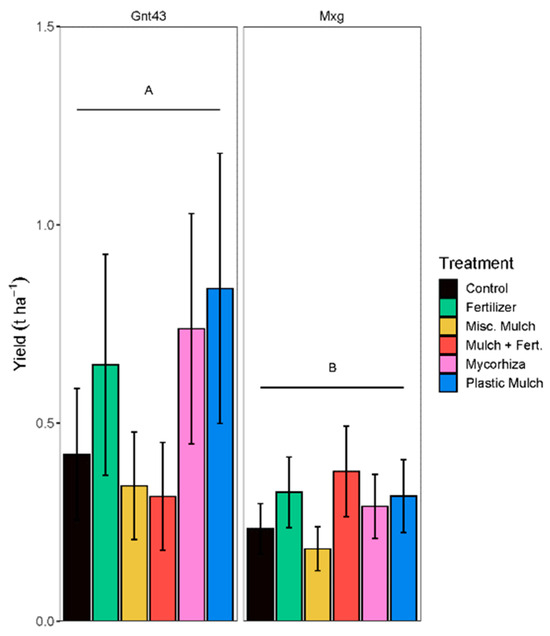
Figure 14.
Yields of miscanthus hybrids planted at Reichwalde in May 2022. Hybrids with the same letter are not significantly different at α = 0.05.
3.5.3. Survival Rate
The survival rate showed no response to hybrid or treatment. The survival rate was generally between 50% and 75%. It is shown in Appendix A.4.
3.5.4. Soil Samples and Soil Sensors
Soil samples taken at Reichwalde in 2022 showed that the highest mineral nitrogen availability was in the fertilizer treatment, followed by the mulch and fertilizer treatment (Appendix A.5). As at Ihinger Hof, the lowest mineral nitrogen availability was in the miscanthus mulch treatment.
Sensors measuring surface temperature and soil moisture showed that temperatures reached 48 °C and 44 °C under plastic mulch treatments, while temperatures peaked at 37 °C in the control and fertilizer treatments, and 33 °C and 35 °C in the miscanthus mulch treatment (Appendix A.6). Measurements of soil moisture suggested higher moisture in the plastic mulch treatment.
4. Discussion
4.1. General Trends
Plants grew more vigorously and delivered higher yields at Ihinger Hof than at Reichwalde. This was especially apparent in experiments established in 2021. The low nutrient availability at Reichwalde and the dry conditions at the site resulted in sub-optimal growing conditions and highly stunted plants.
Although conditions were more favorable at Ihinger Hof, the shallow soil profile at this site combined with dry conditions resulted in drought stress in 2022. This was advantageous for the experiment as it made the drought-tolerant phenotype of Gnt10 visible.
The novel hybrids tested here behaved differently to the standard hybrid Mxg. The hybrids Gnt10 and Gnt43 that originate from broad crosses between Chinese M. sacchariflorus and Japanese M. sinensis outperformed Mxg and the intraspecies M. sinensis hybrid Syn55.
The following sections discusses the applied treatments in detail, followed by the hybrids planted in experiments individually, followed by a general discussion.
4.2. Treatments
4.2.1. Planting Date
Several studies have examined the impact of planting date on the establishment success of miscanthus [20,24]. Planting can occur as soon as temperatures exceed the base growth temperature for miscanthus, variously estimated as between +6 and +10 °C [23,40].
In the Ihinger Hof A experiment, planting date had a significant effect on stem number, and for other variables showed a significant interaction with treatment. Plants in the plastic mulch treatment at the early planting date were approximately 27 cm taller that in the same treatment at the later planting date, and had more stems. For miscanthus mulch, late-planted plants were 13 cm taller than their early-planted counterparts. This difference was also visible in yield in 2021, where late-planted plastic mulch treatments yielded an average of 3.36 tha−1 compared with 1.84 t ha−1 for early plantings. For miscanthus mulch, late plantings yielded 1.1 tha−1 compared with 0.58 tha−1 for early plantings. The difference in yield seen in miscanthus mulch treatments across planting dates may be due to the insulator effect of miscanthus mulch. The soil had more time to warm before the later planting date, increasing nitrogen mineralization in the soil. At the early planting date, the soil was likely cooler and less mineralization had occurred.
The survival of late-planted Syn55, Mxg, and Gnt43 was higher than in the early planting date, but for Mxg and Gnt43 this may be due to different planting material used. Temperature data show that in the two weeks following the early planting date, temperatures hovered between 9 and 11 °C, the base temperature for miscanthus growth. Following the late planting, temperatures rapidly rose, likely aiding establishment.
Kaiser and Sacks [24] argue that due to significant differences in the cold tolerance of various hybrids, the planting date should be selected on a hybrid basis, an argument bolstered by the work of Farrell et al. [23], who found significant differences in the chilling tolerance of seedlings. At the sites tested in this experiment, an early planting date would be advantageous when combined with plastic mulch; otherwise, a planting date as soon as temperatures exceed the base growing temperature could be recommended.
4.2.2. Plastic Mulch
Plastic mulch treatments have been examined by a number of studies [27,28,29,30,41], with typically positive results. Olave et al. [29] reported an increase in biomass yield of greater than 30 percent as well as a dramatic increase in stem number in a trial in northern Ireland. Similarly, Ashman et al. [28] reported increased establishment rates, stem counts, and height, and a shorter period to achieve peak yields.
These experiments contrast with the results obtained here. Plastic mulch had a negligible or negative effect on plant height, stem count, and yield, and was never significantly better than the control treatment. Only in the survival rate for Syn55 in the Ihinger Hof B experiment was the plastic mulch superior to the control. In some cases, plastic mulch plants were taller than the control, though this may in part be due to the lower plant density in these stands due to plants dying shortly after planting. In the Ihinger Hof A and Reichwalde A experiments, plastic mulch harmed many plants, drastically reducing the survival rate. Sensors placed in the Reichwalde B experiment recorded temperatures of 48 °C in the first month following planting, well beyond the level expected to cause stress in miscanthus.
Most studies carried out on plastic mulch were carried out in temperate climates in Ireland and Wales. These climates are cooler than in southern Germany and differ from the continental climate at Reichwalde. One negative report of the use of plastic mulch comes from Ashman et al. [28], where a commercial planting using plastic mulch had to be abandoned due to dry and hot conditions post planting, which resulted in a lower survival rate, similar to what was observed in this experiment. Krzyżak et al. [41] also found a negative effect on survival under plastic mulch, with the caveat that some plants in this treatment were taller.
The main stress factors in play at Ihinger Hof and Reichwalde are sandy soils, shallow soils, and dry periods following planting. Plastic mulch, which increases temperature directly following planting, may exacerbate these marginality factors by placing plants under heat stress. This treatment cannot be recommended for the continental Reichwalde site. An earlier planting date at Ihinger Hof may benefit from plastic mulch to help plants reach the base growing temperature. This would not be possible at Reichwalde due to waterlogging, which renders the field inaccessible until May. This highlights the importance of choosing agronomic interventions based on the prevailing conditions at the site.
4.2.3. Miscanthus Mulch
Plants grown under miscanthus mulch had fewer stems on average, were smaller, and had very low yields. Shortly after planting, plants began turning yellow due to immobilization of nitrogen in the soil. This is due to the high C:N ratio of shredded miscanthus. Farmers typically increase fertilizer application when straw is brought into the field to avoid this effect. Soil sampling in the Ihinger Hof B and Reichwalde B experiments (Appendix A.1 and Appendix A.5) showed that mineral nitrogen was less available under this treatment, confirming the theory. The experiments Ihinger Hof B and Reichwalde B tested whether it was possible to compensate for the immobilization effect through fertilization; however, the miscanthus plus fertilizer treatment performed similarly poorly to the standard miscanthus mulch treatment. Sampling at Reichwalde B suggested that mineral nitrogen was available despite the mulch, which may indicate that the effect of the mulch layer as an insulator also likely played a role.
In the Ihinger Hof A experiment, miscanthus mulch was applied without an accompanying herbicide to test whether the mulch material has an herbicide effect. Despite the 3–5 cm thick layer of miscanthus, weed species were able to grow rapidly such that an herbicide treatment was necessary to ensure the survival of the miscanthus stand. This increased competition with weed species early in the season also had an effect on the growth of these stands.
This treatment cannot be recommended and would not be feasible in practice. The amount of miscanthus required to cover a miscanthus plantation is several tonnes, and this would need to be sourced in addition to planting material. A possible scenario might be using the shredded miscanthus harvest of one field to help establish neighboring fields, but the effects seen in this experiment do not justify the expense.
4.2.4. Mycorrhiza, Planting Material, and Overwintering
The mycorrhiza treatment was carried out in combination with Gnt43 in the Reichwalde A experiment, and with Gnt43 and Mxg in Reichwalde B. Kane et al. [42] suggest that miscanthus enters into symbiotic relationships with arbuscular mycorrhizal fungi under low-nitrogen conditions, such as those at the Reichwalde site. In Reichwalde A, the mycorrhiza seemed to have a somewhat negative effect on the growth of Gnt43, while in Reichwalde B a mild positive effect was observed. More observation would be necessary to discern if this treatment is beneficial.
The Ihinger Hof A experiment contained two types of Gnt43 planting material: overwintered at the first planting date, and a control at the second planting date. The effect of overwintering was thus confounded with planting date, though it appears that the overwintered planting material had a negative effect on survival. Nevertheless, yields of the first planting date of Gnt43 were satisfactory. Two kinds of Mxg planting material were used at the Ihinger Hof A experiment due to a delay in the delivery of Mxg at the first planting date. The plants used at the second planting date were grown in large plots of ~1 L volume. These plants had the highest survival rate in the experiment, corroborating the finding of Ashman et al. [25] that increasing volume increases establishment success.
4.3. Hybrids
4.3.1. Syn55
Syn55 was the poorest performing hybrid at all experimental sites, with the lowest yields and establishment rates. Planting material produced in the greenhouse was of poorer quality than Gnt43, despite being sown under the same conditions. In the Ihinger Hof B experiment, Syn55 was a poor performer, while other hybrids had high survival rates. The yield series shown in Lewin et al. [43] suggests that Syn55 yields are particularly low in the first year after establishment, but may rise quickly from year 3 onwards. The time frame examined in this paper was not sufficient to determine if this is the case. Whatever yield curve Syn55 may have, the low survival rate indicates a high sensitivity to marginal conditions compared with the other hybrids. Ouattara et al. [22] tested various planting densities of Miscanthus sinensis and suggested that higher planting densities reach peak yields quicker. Planting a higher density of Syn55 would ensure establishment and minimize the time to reach peak yield.
4.3.2. Gnt10
Gnt10 produced high yields at Ihinger Hof, comparable to those of Gnt43. In 2022 the Gnt10 control was the highest yielding of all hybrid–treatment combinations. This is especially impressive as Gnt10 plantlets were extremely small at planting, circa 15 cm. The Gnt10 hybrid showed good drought tolerance during the particularly dry summer of 2022. This is immediately evident in Figure 2, where Gnt10 remains green while Mxg and Gnt43 becomes prematurely senescent and loses leaves due to water stress. Krzyżak et al. [44] argue that Gnt10 shows isohydric behavior, that is, controlling water potential within the plant through stomatal regulation to withstand water stress. They found Gnt10 to be more tolerant of water and heavy metal stress than Mxg. This corroborates the finding of Clifton-Brown et al. [45], who found that under dry conditions on a sandy soil, Gnt10 yielded five times more than Mxg. For this reason, Gnt10 could be recommended for both experimental sites.
4.3.3. Gnt43
Gnt43 was an impressive hybrid as it grew rapidly in the year of establishment and produced high yields. In 2022, it showed susceptibility to drought stress and yields of the control fell behind those of Gnt10. Krzyżak et al. [41] also report extremely large Gnt43 plants in the first year. In the Ihinger Hof B and Reichwalde B experiments, Gnt43 outperformed Mxg and Syn55 by a large margin. Gnt43 could be recommended for a temperate site where water stress is not a significant marginality factor.
4.3.4. Mxg
Mxg is a standard hybrid and makes up the majority of commercially grown miscanthus. However, in this experiment it was consistently outperformed by Gnt10 and Gnt43. The stem count in Mxg decreased in 2022 in the Ihinger Hof A experiment. This pattern, a hook-like curve for stem count, was also observed by Christian et al. [46]. This self-thinning behavior may have consequences for yield. Mxg, in contrast to Gnt10, is known to show anisohydric behavior; it does not maintain water potential under water stress conditions [29]. This was evident in 2022, when it began to senesce prematurely in response to water stress (Figure 2). Mxg was not the best performing hybrid and had the function of a control in this experiment for comparison with newer hybrids. The superior performance of the novel hybrid compared to Mxg is evidence of success in breeding miscanthus.
4.4. Increasing Success in Future Experiments
The treatments used in this experiment did not perform consistently better than the control due to the warm, dry conditions following planting. Ultimately, the most important factor in the establishment of miscanthus is survival rate. This is ensured by adequate moisture after planting, growth temperatures above the base temperature from miscanthus, and an absence of frost. Lesur-Dumoulin et al. [15] found that yield was strongly affected by the shoot density established in the first year. They also found a strong association between low yields and weed pressure. Hence, a miscanthus stand with large gaps must be replanted, as this will lead to weed pressure and lower yields, whereas a miscanthus stand with a plant density sufficient for canopy closure can remain despite lower-than-average yields in the first year. It has been noted by multiple authors that miscanthus stands approach peak yields with or without treatments, and that the effect of interventions such as plastic mulch becomes less detectable over time [22,27]. Conversely, the upper limit of miscanthus stand density is fixed after the first winter, and this cannot be increased afterwards without complete replanting. In other words, the effects of treatments are temporary but the effect of poor survival is permanent.
The main treatments tested in this experiment, plastic mulch and miscanthus mulch, damaged plants at both experimental sites and could not be recommended for these experimental sites. A less risky approach may be to plant at a higher-than-desired density in order to decrease the time required for canopy closure. This would limit weed pressure and ensure that a desirable density was achieved despite losses. Increasing planting density was tested by Ouattara et al. [22], who found that it did not increase yield, but minimized the time taken to reach peak yield. Increasing planting density does not require an extra step and can decrease the time required for canopy closure. It is important to note that stands at Reichwalde did not achieve canopy closure in two years and required repeated weed control measures.
Another possible strategy to monitor establishment is the use of UAVs (unmanned aerial vehicles; drones). These can be used to estimate yield and other growth parameters such as canopy closure and have shown promise in miscanthus research [47]. A UAV could be used to survey newly planted miscanthus fields and identify areas of low establishment. These areas could then be completely removed and replanted using higher quality material to ensure establishment, for example, using a larger pot volume. Using UAVs would help identify areas where replanting makes sense and save resources, as only a modest increase in the amount of planting material would be necessary. This approach could then be reserved for “problem areas” where conditions are particularly marginal.
5. Conclusions
The results of these experiments underline the difficulties of establishing miscanthus on marginal sites. The differences between the two sites shows that site-specific solutions are needed when working on marginal land. What works at one site will not necessarily be successful elsewhere. Stark differences were found between the hybrids examined, though no treatment was found that consistently improved establishment. The results suggest that miscanthus can be grown on marginal land, but that research is still necessary to make this a secure option for stakeholders.
A successful establishment at Reichwalde might involve plantings of Gnt10, due to its drought tolerance, but in a higher density than was used in this experiment. Gnt43 could also be considered as it is easier to multiply than Gnt10 as a seeded hybrid, and performed similarly to Gnt10.
Establishment at Ihinger Hof could be considered successful for Gnt43, Mxg, and Gnt10 in various treatments as satisfactory densities were achieved. Gnt10 could be recommended at this site as it performed well in both years, despite the planting material being of poor quality initially. Gnt43 performed well initially but showed a sensitivity to dry conditions and could not be recommended for a site with a shallow soil profile.
The results of this experiment show that significant progress has been made in miscanthus breeding, with two hybrids performing consistently better than the standard commercial variety. The broad cross between miscanthus varieties from China and Japan has produced varieties with high yield potential and one variety with promising drought tolerance. Future research could help to develop these hybrids further.
Further research should be conducted into agronomic techniques beyond those tested in this experiment. Plastic mulch has been shown by other studies to help under temperature conditions, but treatments that tackle dry conditions immediately following planting are still lacking. Future experiments should seek to develop planting protocols combining agronomic techniques with the promising novel hybrids examined in this study.
Author Contributions
Conceptualization, E.L., J.C.-B., E.J., J.K., M.P. and A.K.; Data curation, E.L. and C.W.; Formal analysis, E.L. and A.K.; Investigation, E.L., C.W. and A.K.; Methodology, E.L., J.H. and A.K.; Project administration, E.J., I.L. and A.K.; Supervision, J.C.-B., E.J., I.L. and A.K.; Validation, J.C.-B.; Visualization, E.L.; Writing—original draft, E.L.; Writing—review and editing, J.C.-B., I.L., C.W. and A.K. All authors have read and agreed to the published version of the manuscript.
Funding
The Miscomar+ project was funded by the German Federal Ministry for Research and Education (BMBF, 031B0935A) under the FACCE SURPLUS ERA-NET Cofund.
Data Availability Statement
The data presented in this study are openly available in Dryad at DOI: 10.5061/dryad.k3j9kd5kx.
Acknowledgments
We thank the staff at the “Ihinger Hof” research station for their management of this field trial, as well as the Dagmar Mezger and Theresa Thiel. We thank Uwe Kühn and Carmen Retzala-Kühn for their management of field trials at Reichwalde. The authors have reviewed and edited the output and take full responsibility for the content of this publication.
Conflicts of Interest
The authors declare no conflicts of interest.
Abbreviations
The following abbreviations are used in this manuscript:
| Mxg | Miscanthus x giganteus |
| UAV | Unmanned aerial vehicle |
Appendix A
Appendix A.1. Soil Sampling at Ihinger Hof

Figure A1.
Mineral nitrogen measured in the Ihinger Hof B experiment. Measurements were taken from the 0–30 cm soil horizon in 2022.
Appendix A.2. Yield in the Reichwalde A Experiment in 2021 and 2022
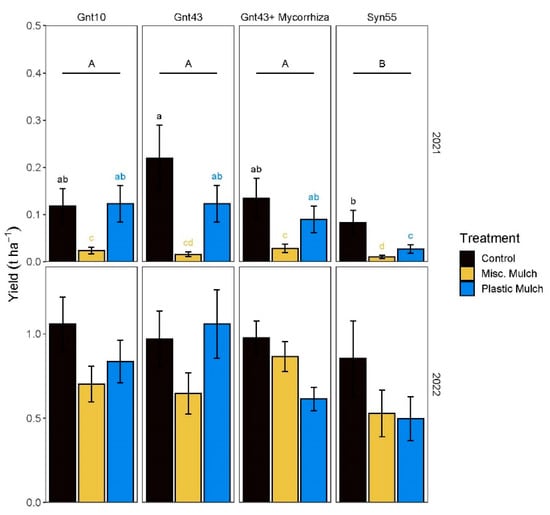
Figure A2.
Yield of various hybrids in the Reichwalde A experiment in 2021 and 2022. Comparisons were carried out within years. Hybrids with the same letter are not significantly different at α = 0.05.
Appendix A.3. Survival Rate in the Reichwalde A Experiment
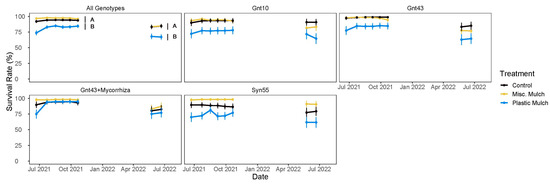
Figure A3.
Survival rate in the Reichwalde A experiment. Treatments with the same letter are not significantly different at α = 0.05.
Appendix A.4. Survival Rate in the Reichwalde B Experiment
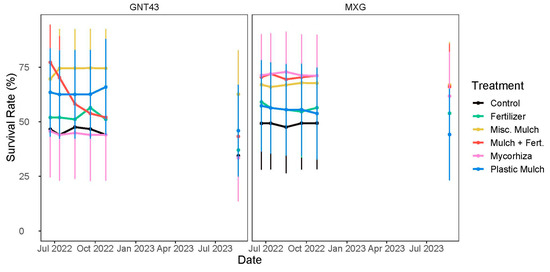
Figure A4.
Survival rate in the Reichwalde B experiment in 2022 and 2023.
Appendix A.5. Soil Sampling at Reichwalde

Figure A5.
Mineral nitrogen measured in the Reichwalde B experiment. Measurements were taken from the 0–30 cm soil horizon.
Appendix A.6. Tempearture Sensor Data
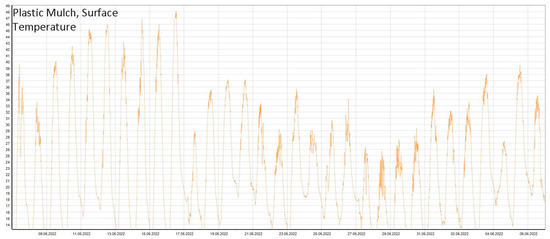
Figure A6.
Surface temperature measured in the plastic mulch treatment from 7 May to 7 June 2022 in the Reichwalde B experiment. Temperatures reached 48 °C on 16 May 2022.
References
- Kungliga Svenska Vetenskapsakademien. Öfversigt af Kongl. Vetenskaps-Akademiens Forhandlingar; Stockholm P. A. Norstedt & Söner: Stockholm, Sweden, 1862. [Google Scholar]
- Heaton, E.A.; Dohleman, F.G.; Long, S.P. Meeting US Biofuel Goals with Less Land: The Potential of Miscanthus. Glob. Change Biol. 2008, 14, 2000–2014. [Google Scholar] [CrossRef]
- Kiesel, A.; Lewandowski, I. Miscanthus as Biogas Substrate—Cutting Tolerance and Potential for Anaerobic Digestion. GCB Bioenergy 2017, 9, 153–167. [Google Scholar] [CrossRef]
- Moll, L.; Wever, C.; Völkering, G.; Pude, R. Increase of Miscanthus Cultivation with New Roles in Materials Production—A Review. Agronomy 2020, 10, 308. [Google Scholar] [CrossRef]
- McCalmont, J.P.; Hastings, A.; McNamara, N.P.; Richter, G.M.; Robson, P.; Donnison, I.S.; Clifton-Brown, J. Environmental Costs and Benefits of Growing Miscanthus for Bioenergy in the UK. GCB Bioenergy 2017, 9, 489–507. [Google Scholar] [CrossRef] [PubMed]
- Mazur, A.; Kowalczyk-Juśko, A. The Assessment of the Usefulness of Miscanthus x Giganteus to Water and Soil Protection against Erosive Degradation. Resources 2021, 10, 66. [Google Scholar] [CrossRef]
- Clifton-Brown, J.C.; Breuer, J.; Jones, M.B. Carbon Mitigation by the Energy Crop, Miscanthus. Glob. Change Biol. 2007, 13, 2296–2307. [Google Scholar] [CrossRef]
- Mehmood, M.A.; Ibrahim, M.; Rashid, U.; Nawaz, M.; Ali, S.; Hussain, A.; Gull, M. Biomass Production for Bioenergy Using Marginal Lands. Sustain. Prod. Consum. 2017, 9, 3–21. [Google Scholar] [CrossRef]
- Thompson, P. The Agricultural Ethics of Biofuels: The Food vs. Fuel Debate. Agriculture 2012, 2, 339–358. [Google Scholar] [CrossRef]
- Mellor, P.; Lord, R.A.; João, E.; Thomas, R.; Hursthouse, A. Identifying Non-Agricultural Marginal Lands as a Route to Sustainable Bioenergy Provision—A Review and Holistic Definition. Renew. Sustain. Energy Rev. 2021, 135, 110220. [Google Scholar] [CrossRef]
- Csikós, N.; Tóth, G. Concepts of Agricultural Marginal Lands and Their Utilisation: A Review. Agric. Syst. 2023, 204, 103560. [Google Scholar] [CrossRef]
- European Commission; Joint Research Centre; Institute for Environment and Sustainability. Updated Common Bio-Physical Criteria to Define Natural Constraints for Agriculture in Europe: Definition and Scientific Justification for the Common Biophysical Criteria; Technical Factsheets JRC68682; Publications Office: Luxembourg, 2012. [Google Scholar]
- Xue, S.; Lewandowski, I.; Wang, X.; Yi, Z. Assessment of the Production Potentials of Miscanthus on Marginal Land in China. Renew. Sustain. Energy Rev. 2016, 54, 932–943. [Google Scholar] [CrossRef]
- Shepherd, A.; Awty-Carroll, D.; Kam, J.; Ashman, C.; Magenau, E.; Martani, E.; Kontek, M.; Ferrarini, A.; Amaducci, S.; Davey, C.; et al. Novel Miscanthus Hybrids: Modelling Productivity on Marginal Land in Europe Using Dynamics of Canopy Development Determined by Light Interception. GCB Bioenergy 2023, 15, 444–461. [Google Scholar] [CrossRef] [PubMed]
- Lesur-Dumoulin, C.; Lorin, M.; Bazot, M.; Jeuffroy, M.; Loyce, C. Analysis of Young Miscanthus × giganteus Yield Variability: A Survey of Farmers’ Fields in East Central France. GCB Bioenergy 2016, 8, 122–135. [Google Scholar] [CrossRef]
- Zimmermann, J.; Styles, D.; Hastings, A.; Dauber, J.; Jones, M.B. Assessing the Impact of within Crop Heterogeneity (‘Patchiness’) in Young Miscanthus × giganteus Fields on Economic Feasibility and Soil Carbon Sequestration. GCB Bioenergy 2014, 6, 566–576. [Google Scholar] [CrossRef]
- Lesur, C.; Jeuffroy, M.-H.; Makowski, D.; Riche, A.B.; Shield, I.; Yates, N.; Fritz, M.; Formowitz, B.; Grunert, M.; Jorgensen, U.; et al. Modeling Long-Term Yield Trends of Miscanthus×giganteus Using Experimental Data from across Europe. Field Crops Res. 2013, 149, 252–260. [Google Scholar] [CrossRef]
- Lewandowski, I.; Clifton-Brown, J.C.; Scurlock, J.M.O.; Huisman, W. Miscanthus: European Experience with a Novel Energy Crop. Biomass Bioenergy 2000, 19, 209–227. [Google Scholar] [CrossRef]
- Winkler, B.; Mangold, A.; Von Cossel, M.; Clifton-Brown, J.; Pogrzeba, M.; Lewandowski, I.; Iqbal, Y.; Kiesel, A. Implementing Miscanthus into Farming Systems: A Review of Agronomic Practices, Capital and Labour Demand. Renew. Sustain. Energy Rev. 2020, 132, 110053. [Google Scholar] [CrossRef]
- Ashman, C.; Wilson, R.; Mos, M.; Clifton-Brown, J.; Robson, P. Improving Field Establishment and Yield in Seed Propagated Miscanthus through Manipulating Plug Size, Sowing Date and Seedling Age. Front. Plant Sci. 2023, 14, 1095838. [Google Scholar] [CrossRef]
- Davies, M.J.; Longbottom, H.; Atkinson, C.J. Changes in Duration of Rhizome Cold Storage and Manipulation of the Growing Environment to Promote Field Establishment of Miscanthus Giganteus. Biomass Bioenergy 2011, 35, 4268–4279. [Google Scholar] [CrossRef]
- Ouattara, M.S.; Laurent, A.; Barbu, C.; Berthou, M.; Borujerdi, E.; Butier, A.; Malvoisin, P.; Romelot, D.; Loyce, C. Effects of Several Establishment Modes of Miscanthus × giganteus and Miscanthus sinensis on Yields and Yield Trends. GCB Bioenergy 2020, 12, 524–538. [Google Scholar] [CrossRef]
- Kaiser, C.M.; Sacks, E.J. Cold-Tolerance of Miscanthus Seedlings and Effects of Spring and Autumn Frosts on Mature Clonally Replicated Cultivars. Crop Sci. 2015, 55, 2401–2416. [Google Scholar] [CrossRef]
- Farrell, A.D.; Clifton-Brown, J.C.; Lewandowski, I.; Jones, M.B. Genotypic Variation in Cold Tolerance Influences the Yield of Miscanthus. Ann. Appl. Biol. 2006, 149, 337–345. [Google Scholar] [CrossRef]
- Clifton-Brown, J.; Hastings, A.; Mos, M.; McCalmont, J.P.; Ashman, C.; Awty-Carroll, D.; Cerazy, J.; Chiang, Y.; Cosentino, S.; Cracroft-Eley, W.; et al. Progress in Upscaling Miscanthus Biomass Production for the European Bio-economy with Seed-based Hybrids. GCB Bioenergy 2017, 9, 6–17. [Google Scholar] [CrossRef]
- Awty-Carroll, D.; Iurato, A.; Scordia, D.; Schwarz, K.-U.; Scalici, G.; Robson, P.; Mos, M.; Webster, R.; Cosentino, S.; Clifton-Brown, J.; et al. Achieving Hybridisation between Miscanthus Species: Commercially-Scalable Methods to Manipulate Flowering Synchronisation and Maximise Seed Yield. Ind. Crops Prod. 2024, 219, 119116. [Google Scholar] [CrossRef]
- Ashman, C.; Awty-Carroll, D.; Mos, M.; Robson, P.; Clifton-Brown, J. Assessing Seed Priming, Sowing Date, and Mulch Film to Improve the Germination and Survival of Direct-sown Miscanthus sinensis in the United Kingdom. GCB Bioenergy 2018, 10, 612–627. [Google Scholar] [CrossRef]
- Ashman, C.; Awty-Carroll, D.; Mos, M.; Kam, J.; Guerrini, S.; Calder, S.; Clifton-Brown, J. Developing Miscanthus Seed Plug Establishment Protocols with Mulch Film for Commercial Upscaling. GCB Bioenergy 2023, 15, 746–764. [Google Scholar] [CrossRef]
- Olave, R.J.; Forbes, E.G.A.; Munoz, F.; Laidlaw, A.S.; Easson, D.L.; Watson, S. Performance of Miscanthus x Giganteus (Greef et Deu) Established with Plastic Mulch and Grown from a Range of Rhizomes Sizes and Densities in a Cool Temperate Climate. Field Crops Res. 2017, 210, 81–90. [Google Scholar] [CrossRef]
- O’Loughlin, J.; McDonnell, K.; Finnan, J. Establishing Miscanthus x Giganteus Crops in Ireland through Nodal Propagation by Harvesting Stems in Autumn and Sowing Them Immediately into a Field. Biomass Bioenergy 2017, 107, 345–352. [Google Scholar] [CrossRef]
- Xue, S.; Kalinina, O.; Lewandowski, I. Present and Future Options for Miscanthus Propagation and Establishment. Renew. Sustain. Energy Rev. 2015, 49, 1233–1246. [Google Scholar] [CrossRef]
- Zheng, C.; Xue, S.; Xiao, L.; Iqbal, Y.; Sun, G.; Duan, M.; Yi, Z. “Two-steps” Seed-derived Plugs as an Effective Propagation Method for the Establishment of Miscanthus in Saline–Alkaline Soil. GCB Bioenergy 2021, 13, 955–966. [Google Scholar] [CrossRef]
- Agrarmeteorologie Baden-Würrtemberg Wetterstation Ihinger Hof 2023. Available online: https://www.wetter-bw.de/Internet/AM/NotesBwAM.nsf/bwweb/095e00fe589ba5d7c1257ca8002cc942?OpenDocument&TableRow=3.1 (accessed on 16 April 2025).
- Sächsisches Staatsministerium für Energie, Klimaschutz, Umwelt und Landwirtschaft Agrarmeteorologisches Messnetz Sachsen—Wetterdaten Reichwalde. Available online: https://www.landwirtschaft.sachsen.de/Wetter09/asp/inhalt.asp?seite=uebersicht (accessed on 16 April 2025).
- Wild, J.; Kopecký, M.; Macek, M.; Šanda, M.; Jankovec, J.; Haase, T. Climate at Ecologically Relevant Scales: A New Temperature and Soil Moisture Logger for Long-Term Microclimate Measurement. Agric. For. Meteorol. 2019, 268, 40–47. [Google Scholar] [CrossRef]
- SAS, Version 9.4.; SAS Institute Inc.: Cary, NC, USA, 2023.
- RStudio Team. R Studio Integrated Development for R. 2020. Available online: https://www.r-project.org/conferences/useR-2011/abstracts/180111-allairejj.pdf (accessed on 16 April 2025).
- Wolfinger, R.; O’Connell, M. Generalized Linear Mixed Models a Pseudo-Likelihood Approach. J. Stat. Comput. Simul. 1993, 48, 233–243. [Google Scholar] [CrossRef]
- ArcGIS, Pro 3.5. Box—Cox, Arcsine, and Log Transformations. Esri: Redlands, CA, USA, 2023.
- Robson, P.R.H.; Donnison, I.S.; Clifton-Brown, J.C. Stem Growth Characteristics of High Yielding Miscanthus Correlate with Yield, Development and Intraspecific Competition within Plots. GCB Bioenergy 2019, 11, 1075–1085. [Google Scholar] [CrossRef]
- Krzyżak, J.; Rusinowski, S.; Sitko, K.; Szada-Borzyszkowska, A.; Stec, R.; Jensen, E.; Clifton-Brown, J.; Kiesel, A.; Lewin, E.; Janota, P.; et al. The Effect of Different Agrotechnical Treatments on the Establishment of Miscanthus Hybrids in Soil Contaminated with Trace Metals. Plants 2022, 12, 98. [Google Scholar] [CrossRef]
- Kane, J.L.; Liseski, K.B.; Dang, C.; Freedman, Z.B.; Morrissey, E.M. Trade or Scavenge? Miscanthus-Microbiome Interactions Depend upon Soil Fertility. Appl. Soil Ecol. 2024, 196, 105289. [Google Scholar] [CrossRef]
- Lewin, E.; Clifton Brown, J.; Magenau, E.; Jensen, E.; Mangold, A.; Lewandowski, I.; Kiesel, A. Yield Development and Nutrient Offtake in Contrasting Miscanthus Hybrids under Green and Brown Harvest Regimes. GCB Bioenergy 2024, 16, e13149. [Google Scholar] [CrossRef]
- Krzyżak, J.; Rusinowski, S.; Sitko, K.; Szada-Borzyszkowska, A.; Stec, R.; Janota, P.; Jensen, E.; Kiesel, A.; Pogrzeba, M. The Effect of Combined Drought and Trace Metal Elements Stress on the Physiological Response of Three Miscanthus Hybrids. Sci. Rep. 2023, 13, 10452. [Google Scholar] [CrossRef] [PubMed]
- Clifton-Brown, J.; Schwarz, K.-U.; Awty-Carroll, D.; Iurato, A.; Meyer, H.; Greef, J.; Gwyn, J.; Mos, M.; Ashman, C.; Hayes, C.; et al. Breeding Strategies to Improve Miscanthus as a Sustainable Source of Biomass for Bioenergy and Biorenewable Products. Agronomy 2019, 9, 673. [Google Scholar] [CrossRef]
- Christian, D.G.; Riche, A.B.; Yates, N.E. Growth, Yield and Mineral Content of Miscanthus×giganteus Grown as a Biofuel for 14 Successive Harvests. Ind. Crops Prod. 2008, 28, 320–327. [Google Scholar] [CrossRef]
- Impollonia, G.; Croci, M.; Ferrarini, A.; Brook, J.; Martani, E.; Blandinières, H.; Marcone, A.; Awty-Carroll, D.; Ashman, C.; Kam, J.; et al. UAV Remote Sensing for High-Throughput Phenotyping and for Yield Prediction of Miscanthus by Machine Learning Techniques. Remote Sens. 2022, 14, 2927. [Google Scholar] [CrossRef]
Disclaimer/Publisher’s Note: The statements, opinions and data contained in all publications are solely those of the individual author(s) and contributor(s) and not of MDPI and/or the editor(s). MDPI and/or the editor(s) disclaim responsibility for any injury to people or property resulting from any ideas, methods, instructions or products referred to in the content. |
© 2025 by the authors. Licensee MDPI, Basel, Switzerland. This article is an open access article distributed under the terms and conditions of the Creative Commons Attribution (CC BY) license (https://creativecommons.org/licenses/by/4.0/).